(I)MAGESOUND(S)
Expanded audiovisual practice
(I)MAGESOUND(S) is a collaborative audiovisual project led by artist Jim Hobbs and composer Andrew Hill. It seeks to bring together the practices of experimental film and electroacoustic music to create live, expanded audiovisual performances. The goals of the project are to combine, share and reflect upon creative practice through the creation of expanded cinema events exploring the materiality of sound and light. To this end, here we describe two works developed as part of this project: Vientos Fuertes by Jim Hobbs and Projections by Andrew Hill.
Expanded Practices
One no longer can specialize in a single discipline and hope truthfully to express a clear picture of its relationships in the environment. (Youngblood 1970, 41)
The rich history and practices of performance and presentation for electroacoustic music and sonic art are likely well known to the reader, encompassing loudspeaker orchestras and diffusion systems, site-specific compositions and installations, mixed music and electronic instrumental performance, and more. It might be argued that all of these are an expansion of musical practices, extending the limitations of acoustic instruments, extending electronic music out of the studio and, with sonic art and site-specific works, even beyond the traditional artistic confines of the gallery or the concert hall.
However, the parallel world of expanded cinema may be less familiar to readers. Expanded cinema, as a term, was firmly established by the seminal 1970 text of the same name by Gene Youngblood. While it has since been used to describe experimental films and film performance beyond the cinema, it began (in the spirit of those times) as a more utopian ideal:
Expanded cinema does not mean computer films, video phosphors, atomic light, or spherical projections. Expanded cinema isn’t a movie at all: like life it’s a process of becoming, man’s ongoing historical drive to manifest his consciousness outside of his mind. (Youngblood 1970, 41)
Therefore, its primary focus was always upon communicating æsthetic experience and not the adoption of specific methods of production or workflows. In contrast, Philip Tagg notes that the majority of contemporary musical study is directed towards the poietic processes, the actions of creation, as opposed to the æsthesic perception of musical works (Tagg 2011, 2). Derek Scott identifies these tendencies as stemming from the sociocultural context of Western music:
The romantic and modernist interpretations of music history emphasized formal and technical values, novelty and compositional “coups”. The stress was on the composition in itself and its place in an autonomous musical process. (Scott 2001, 137)
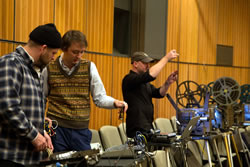
The goal of the current project was to seek to adopt ideas and perspectives from expanded cinema and to use them to reflect upon, and merge with, electroacoustic music ideas and practices. We sought to reconcile divergent perspectives on both work presentation and composition, and to investigate where approaches from experimental film and electroacoustic music performance might be brought together in the creation of an audiovisual expanded cinema programme.
Expanded cinema situates itself as a fundamentally intermedia practice within which artistic autonomy is actively undermined, “both on the level of the work itself and on that of the artistic institution” (Mey 2015, 51). The (I)MAGESOUND(S) project embraced these potentialities, appropriating existing works as base material for the development of new pieces (audiovisual works created from “silent” film) and inspiring the creation of entirely new works (generating all materials); both of which seek to push the potentialities of where the limits of media and formats might lie. A catalyst for the project was a commission from Mono No Aware to curate and present a show as part of the 2016 edition of their annual cinema arts festival. The MONO X festival was an extended festival, celebrating the tenth anniversary of the 16 mm New York City-based film collective Mono No Aware. With an extensive, month-long programme in venues across New York, the culmination was a long weekend of events that included the presentation of the (I)MAGESOUND(S) project at Lincoln Center.
One of the exciting opportunities of performing at Lincoln Center was the chance to access moving image materials within the New York Public Library. Housed within the Center, the library has a renowned collection of rare and archival materials. This impressive resource served to both inspire the development of new works and provide an archive of experimental films from which new readings could be made. We were also fortunate to have access to works from the LUX Film archives (London), thus providing a transatlantic dimension to the materials explored and incorporated within the project. 1[1. Brooklyn-based musician Dennis McNany (Museum of Love) also joined for this show, in order to further extend the project into other sonic areas.]
The (I)MAGESOUND(S) programme featured an eclectic array of works that were repurposed or reinterpreted for the performance, as well as two newly composed works. All works within the programme were devised afresh, exploring the potentials of collaborative practice and curation of the final programme. According to the intermedia nature of expanded cinema — which considers the audience’s final interpretation as the site of “the work” rather than some media materiality — the reinterpreted works also constitute new artworks rendered for this performance. Novel soundtracks were composed for performance alongside existing films, reinterpreting the originals — not soundtrack as accompaniment, but rather film as graphic score and counterpoint. The soundtracks modulated the experience of the works, expanding and devising new interpretations of the original films. Our focus here will be on the two entirely original works developed as part of this project; more extensive discussion of other works on the programme can be explored in another (future) context.
Original Works and Performance
The two original works presented at MONO X (discussed in detail below) were Vientos Fuertes (2016), an improvised performance involving 16 mm film, recorded sound and sampled sound, and Projections (2016), a post-acousmatic composition for 16 mm film projector and fixed-media recorded sound.
The two works were developed in tandem and through mutual discussion, exploring notions of expanded cinema and audiovisual performance, which Ana Carvalho and Cornelia Lund delimit as liveness, intermediality, performativity and cinematicity (Carvalho and Lund 2015, 17). Each of these elements featured within the discussion and development process of the works, even if they were not defined explicitly at the time or expressed in the same terms as those set out by Lund and Carvalho.
These two works share similarities with each other, despite being rendered within distinct media. Both seek to evoke a connection between material and æsthetic, to draw forward the methods of production and the material of the artwork, in order to position them at the forefront of the performance and integrated in the æsthetic of the work. To this end, the processes and concepts occurring throughout its development are significant aspects of the final work, foregrounded for the audience to experience within the final performance. Embracing the materiality and affordances of the medium and of the physical nature of the source.
The ultimate goal of our programme was to create an immersive and enveloping experience, beyond that of a gallery screening or traditional concert performance. 2[2. Akin to the expanded cinema performances of the 1970s (e.g., Stan VanDerBeek, Malcolm Le Grice, etc.)] Therefore, notions of performance and theatre — the latter often neglected in electroacoustic music practice — were key to this event (see Hill 2015). The fact that the performance was to take place in a library, a site of quiet contemplation, encouraged us to push against this and to ensure that sounds were projected assertively into the space and around the audience. A loudspeaker system was brought into the auditorium to provide sound projection into the space. Although the system was small and simple, and afforded only a relatively limited number of channels, it nevertheless provided a sufficient output SPL to create an enveloping audio experience. The goal was to make the audio tangible within the space — perhaps not quite as extreme as something like a Merzbow concert, but certainly providing an impression of the audio spilling out beyond the stage and connecting tangibly with the audience. David Callahan, librarian and director of the venue rather appreciated this, stating after the concert: “The walls were shaking. It was great!” 3[3. Much to our relief!]
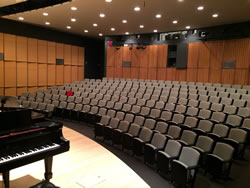
The venue itself, The Bruno Walter Auditorium, is a traditional concert auditorium with a separate projection booth for screening films (Fig. 2). It has therefore been designed to present both music and film within a traditional framework, masking the methods of production, hiding away the technology of reproduction and foregrounding the human presence of the music performer on stage (or the film as pure content). However, because our intention was to break free from the restricted confines of the traditional performance paradigms in order to unleash the potentials of a truly expanded theatre of performance that highlighted the materiality of sound and light, we were keen to dissolve the traditional façade and thereby reveal the mechanisms and technology of production — as well as their human operators — to the audience. One solution would have been to take advantage of the stage, and to position performers at the front of the space, up with the image. This notion of including the performer in front of the screen and visible to the audience is a popular approach within audiovisual practice, and functions to provide a single visual point of reference for the audience. However, we felt that the human presence would detract from the materials of the works, and thus sought to limit the distracting human presence from the stage so that light and sound remained the primary focus of audience (this was particularly acute in relation to the work Projections, discussed below). A foregrounded human agency was not desirable.
An important component of the piece is that the audience recognize they are experiencing a live performance event in which performer and machine interacted dynamically, and not simply a fixed screening in which a pre-packaged content was delivered. Therefore, the decision was made to situate the performers at the back of the auditorium, taking up the rear two rows of seats (Fig. 1, above). This positioned the projectors and sound equipment in the space with the audience, and yet without the human presence overshadowing the material of the work (akin to the positioning of a diffusion console at a loudspeaker orchestra concert). Further, the visual appearance and sounds emanating from the tools which realized the event became part of the final æsthetic, merging the methods of production into the final result and expanding the cinematic experience to something more communal and with presence in the physical space.
The process of negotiation and development which led to this setup took place alongside the development of the original works within the programme. Its outcome and format therefore became embedded within their composition, allowing the opportunity for the works to take full advantage of this expanded setup. Having all performers and tools in proximity and surrounded by the audience also afforded opportunities for specific artistic ideas to develop and grow, and thus inspired concepts that directed the final works. The discussion in the following sections covers the development and realization of these two original works, encompassing both the methods of production and the processes that led to the final result.
Jim Hobbs — Vientos Fuertes (2016): Notes on a Project
The following text has been composed in a format that offers the reader a glimpse into the linear (and non-linear or tangential) processes within the project. Structured loosely in chronological order, the entries are personal anecdotes and observations made by Jim Hobbs over the course of two years. While it would be impossible in this space to detail all the concepts and themes contained in the work, it will give the reader a “flavour” of the process within this collaborative and personal project.
It has been suggested that the work and process of expanded cinema might be best described as “poetism”:
Coined and theorized by the Czech avant-garde artist and critic Karel Teige, poetism identified a spectrum of work in poetry and painting that had managed to break from, respectively, literature and representation, and eventually provided a conception of art cutting across disciplines. (Mey 2015, 59)
It is in this spirit that the following discussion of the expanded cinema work Vientos Fuertes takes the form of a poetic description of the processes of creation and the eventual performance of the work.
A thumbnail sketch a jeweller’s stone
A mean idea to call my own […]
Standing on the shoulders of giants leaves me cold
—“King of Birds”, R.E.M. (1987), attrib. Newton, attrib. Bernard, attrib.…
July 2015
It’s good to be out of London. A walk through the High Weald, along the River Brede… views stretch out towards the sea, but in the distance I can spot a gang of giants, standing at odds with what should presumably (naively / romantically?) be a bucolic scene. The light that hits them makes them seem… pure. But, they are ugly. No, they are beautiful. They are contentious. They are stirring. They are political. They are monuments. They are huge. They are small. They are upward brushstrokes on a horizon. They are white shadows. They are machinery. They are modern. They are linked to the power lines in front of me. They disrupt the landscape.
They are the landscape.
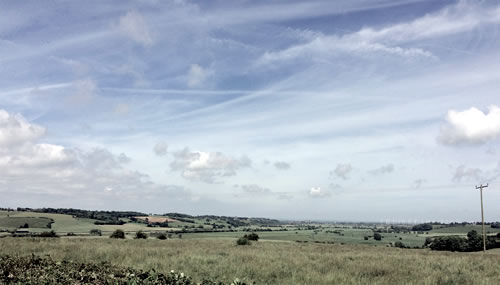
They bring to mind a conversation I had with a painter friend about ideas of scale, and how often we confuse / misuse the terms of size and scale. Size is an objective measure. Scale is a relationship between things. From here, it is hard to be sure of either…
April 2016
The shadows sweep across the fields with unsuspecting and brute physicality — shit… look out! I instinctively duck and cover my head in an odd response. Barnaby, my dog, has a similar reaction as he steers clear of this fast-moving shadow… they must be at least a hundred feet long… the shadows (anti-light) have a physical presence that I now want to capture, harness, spew out… as I get nearer to the base there is a better sense of the scale of these “things”, and the size suddenly becomes apparent. I am a dwarf underneath these mechanical megaliths — and I love it… to feel small, to be insignificant, to be subject to these beasts who both scare and intrigue me. Hypnotic. The sounds are imperceptible from far, but underneath the blades… swoosh… swoosh… swoosh… it’s a perfectly timed corporeal sonic #“*&. BRING IT…

The afternoon is spent walking between them, stopping for a time to take in their presence, to gaze upward and outward, to marvel, to feel a real appreciation of the word awesome… reverential respect mixed with fear and wonder… something is brewing…
Damn you Cervantes and your romantic chivalry… has anyone actually read the entirety of Don Quixote? I guess I better give it a go…
October 2016
The gear is heavy and it’s about a mile walk into the site from the road. I’ve been waiting patiently for months now… for a clear, cloudless day — and today is it. The wind is from the wrong direction, but it will have to do… it’s hard to train large, dumb animals. There is one shot I need — static, observational, minimal, clinical, simple — but the urge to capture moments is overwhelming and soon I am searching for compositions within the Super 16 mm frame that will turn image into sound.
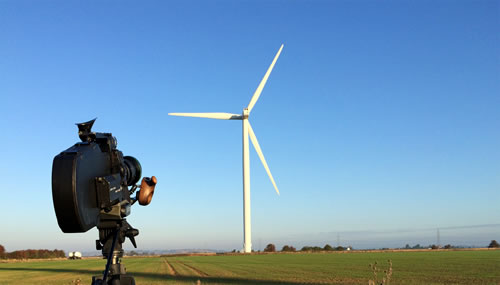
That wonderful idea of optical sound — light as sound — sound as light. The film stock being exposed by the sun, but interrupted by the shadow of the blade to create some sort of alien language to be interpreted by the projector. Unsure and excited, the act of looking minutely through the eyepiece affords me a focus that transforms the beasts into sheer movement and gesture… abstract loops that slice away at the rectangle… from thing to action to abstraction to experience… this is like foraging for material to play with. I am a gatherer of image-sounds in the fields of Sussex…
November 2016
Back in the studio it’s a fucking mess — well, an organized mess… film cans, film strips, splicing tape, projectors, speakers, Post-it notes, sketchbooks, rubber bands… the billiards table and dartboard turned into makeshift workstations. A type of logic is at play here… working through new footage and old… conversations with moving images taken out of context to be combined and choreographed into… something… something that roars… that whispers… that moves through the weather. This is the fun bit… the frustrating bit — the time where play is serious, and the combination of images and sounds yields surprising results… where ideas succeed and fail through manifestation.

I take notes, I draw, I sketch, I cut, tape, splice, fix, compose, stack, layer, split, loop…. I never know what exactly it is that I am making, but as the beams of projected light and film overlap, a form is starting to take shape — a chronology of intended experience. I turn on the projector’s optical sound, and a smile spreads across my face — weird pitches, odd ticking, fast shuttering. These are the noises I was hoping for, and others I could have never known would be born… Some of the material will do, other bits won’t. But overall, I’m like a little kid gleaming with his new toy. I send snippets of sound and images via text to Andrew and DJ like an eager kid who has just got his first smartphone — CHECK THIS OUT! … AWESOME…
Conversations and studio experimentations continue over the month, with each of us sending ideas, notes and tests. Sketches become more concrete, and the form starts to take shape through animatics and written directions. Triple / double / single-screen images will morph over time. Talk of how a slow build into a noise-induced space seems akin to composing a type of sonic score — but one that is physical, that permeates the space, that treats the images in the same way as the sound. There should be a type of narrative that allows recognizable images to slowly become abstractions of light and sound — a type of experience that guides one from cognition into a trance state through the hypnotic movement of the windmills. Then it will be time to attack them, in the way that Quixote did. I imagine a type of 15th-century GoPro mounted on his helmet as he charges the beasts and gets thrown around like a rag doll. I want to feel the shadows running me over, the light strobing like nightmare disco… I want to transform the entire space into light and sound…
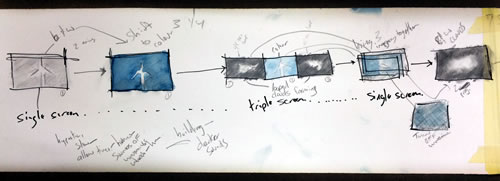
Before I know it, time runs out and I find myself in New York with the loops of film taped up on the apartment wall — still sorting out the details for the performance yet to come. One of the beauties of working live, with collaborators whom you trust, is that there is an exciting potential in the live act — things that may or may not happen. While in theory we have gone over the details, the movements, the timing — we still have not had a chance to practise. I feel nervous… but I like it.
I think back to my original walk, and begin to sense that there is an artwork here that can start to embrace my initial experiences. Looks like this will be an assault on those metaphorical beasts in the landscape. Damn you Cervantes… you’ve made your way back in… these windmills are what we want them to be:
They are giants; and, if you are afraid, get aside and pray, whilst I engage with them in a fierce and unequal combat. (Cervantes 1992, 59)
December 2016
It’s show time. The projectors in the back are lined up and perched on stands straddling the row in front… 16 mm film loops are taped to the projector stands, walls, seats and windows… patching cables are running from the projectors to the mixing desk and out to Andrew’s and DJ’s laptops… the auditorium is dark, really dark, with the exception of small lamps placed next to the projectors. I look over at Andrew and DJ and nod… OK. I look at the projectionist standing next to me and nod… time to synch up and start two of the 16 mm projectors — 1… 2… 3… CLICK!

The auditorium fills with light as two synched and mirrored images of clouds form a type of celestial Rorschach. There is a subtle drone coming from the speakers… humming along… we are falling… we are falling… slowly, a landscape image emerges and is overlaid on top of the diptych… the spinning of the windmills takes over as the main image, and the hum begins to increase in volume. A singular image of a windmill slowly and hypnotically spins and spins and spins and spins and spins… two clouds form and unform on either side… the entire auditorium is filled with light, slow movements, and sound… we bask under the brightness of the images as the sounds wrap around like a comfort blanket… let’s just stay here a little bit longer… then the three images shift and begin to lay on top of each other… clouds engulfing the windmill, trying to swallow it… the sound darkens… the auditorium darkens too… we soon see a single blade cutting across the screen… it is the only source of light in the space… light… dark… light… dark… the optical soundtrack feeds to the mixing desk and is interpreted through software… spit out as a rhythmic, machine-like sound… soon another image of a blade appears, transecting the other… and then another 16 mm loop is added… more sound is being fed in and we are caught in a maelstrom… more abstract lines and movements are added as the sounds increase… this time, strange frequencies that hum and sputter out… there is no pulse, but rather, a cacophonic space filled with flashing light and harsh noise that try to find order, but cannot… we are all performers, working our machines of light and sound to bring something out of them. A blue light starts to emit… strobing… changing white light into blue… oddly, a singular windmill comes and goes — the one that sent us into this trance to begin with… it tries to surface but isn’t able with all the other flashing… slowly things begin to recede… the sounds are still loud but have somehow found pitch within themselves. A blue strobe and white strobe exchange blows through a singular rectangle… eventually the blue strobe overpowers as the noise starts to come down… the formal, harsh borders of the blue screen start to lose their edge, and begin to fall out of focus. The auditorium is darkening now with only a soft, blue pulsating spotlight on the screen… then that light goes out. The sounds continue, slowly fading, like an echo, still reminding us of what just happened. The space is now completely dark and all I can hear is the occasional shifting of someone in their seat…
Andrew Hill — Projections (2016)
Projections is a solo work for 16 mm projector and expanded audio, but one that emerged through, and was forged by, the collaboration. We chose to adopt the term “expanded audio” in order to better contextualize the work within the original programme of expanded cinema films; however, the term could be considered a synonym of acousmatic sound. The 16 mm projector constitutes the visual component of the work, its motions and mechanism providing both light and sound upon which the acousmatic sound embellishes and expands. 4[4. It may be considered contradictory to describe a work as acousmatic and then immediately discuss the visual elements of it, but the two need not be exclusive, as Andrew Lewis suggested in “‘LEXICON’ — Behind the Curtain,” published in eContact! 15.4 — Videomusic.]

The projector is set atop an AV cart stand and sits at right angles to the audience, with the mechanism and shutter on show to the audience, and the lens pointing to the side of the hall. Both the turning of the reels and the light from the bulb create a restrained interplay of shadow and light that slowly unfolds throughout the duration of the performance.
Instead of being wound with 16 mm film, the projector is loaded with a 372 ft reel of magnetic tape. Being opaque, the magnetic tape obviously obstructs the projector’s beam for the majority of the performance, until the reel expires. At which point the light cascades out from the projector, suddenly illuminating the side of the stage and the auditorium. The minimalism of the visual element and the gradual depletion of the tape provide a sense of growing expectation and tension as the work unfolds.
Thus, while perhaps an atypical example of sound / light work, both components of the work form a vital element of the piece. The projector stands upon the stage as “performer” of the work, but it is also the source of the original sound recordings — subsequently processed and transformed within the studio — as well as a dancer of moving parts.
The 16 mm projector contextualizes the acousmatic sounds that are projected through the space on a multi-channel loudspeaker system. Occasionally, the acousmatic soundscape collapses back to the ambient sound of the projector within the room, before surging again to overwhelm and absorb it. The projector provides a tangible visual source for the acousmatic sound, highlighting the materiality of the object the acousmatic sounds seek to explore. The presence of the projector on stage as performer also helps to contextualize the abstracted sonic materials to the audience, who are more familiar with contemporary visual art than sonic arts and electroacoustic composition.
A performance score accompanies the work with directions for the operator / assistant to bring the projector on stage and set it playing (see sidebar). The whole process is planned to enhance the theatre of the event, theatre being an aspect of electroacoustic concerts that is often overlooked.
Development
As the work evolved there were many discussions around the performance element of the piece. It was conceived that there could be a live sound-processing performance element to the work, but this was rejected in favour of foregrounding the projector itself as performer. Human intervention on stage would have objectified the projector and detracted from its role as principal subject of the work. Alone the projector can stand proudly on stage and act as a pivot around which the rest of the work turns. To this end, the performance instructions for the operator include a very specific and reverential approach, explicitly outlining the balance between the 16 mm projector and human operator.
The piece began as a pure acousmatic composition, but developed through the project to include the physical projector’s presence. Drawing back the acousmatic curtain to reveal the source affords the audience associations around which to base their interpretation. This self-contextualizing nature is useful for audiences unfamiliar with electroacoustic music, while also situating the work in a clear relation to the other film pieces within the programme and providing an opportunity for spatial interplay, collapsing down into the 16 mm projector itself and expanding out into the loudspeaker system. This work might then be described as post-acousmatic (Adkins, Scott and Tremblay 2016).
Acousmatic Sound
The “tape” portion of the piece was developed from recordings of 16 mm projectors and recordings of film stock (crunching celluloid). The first batch of recordings were made during the summer of 2016 at Hobbs’ studio in St. Leonards-on-Sea, with subsequent recordings made in the controlled environment of the studio at Greenwich. The initial session captured sounds in a dynamic fashion, by moving the microphone around the object and exploring the various textures emanating from it (Fig. 9). It was important to capture not just the motor sounds of the projector, but also those of the projector in actual use — its mechanical operations, sounds of loading reels, etc. The focus was always upon the projector, as opposed to the operator, but obviously the actions of the operator were reflected in the changes to the sounds emanating from the projector. These explorations formed a solid basis for the development of the project.
Rhythms, tones, buzzing, humming, vibrating, rotating. Clicking, clacking, flicking, stripping, grinding. Looping, repeating, looping, repeating, looping, repeating, looping.

As the work began to coalesce in the studio, it became apparent that some additional materials would need to be recorded and that the work required a greater sense of structure. It was also around this time that we discussed the space of performance and negotiated ideas of the various agencies within the piece. Eventually, it was decided that the projector should be positioned as a performer (it is the subject of the work, after all) and this is when the visual (and sonic) elements of the projector began to really take shape. Thus, the projector itself became a basso continuo against which the recorded sounds move and evolve in counterpoint. The projector thus subverted the original intentions to create an acousmatic piece, transforming the work into a post-acousmatic result.
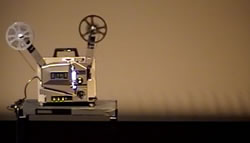

Additional recordings were made to capture the projector in detail from a variety of perspectives using a range of use of multiple close and contact mic recording techniques. But the main body of the work itself was developed in the studios at NOTAM in Oslo during August 2016. The work was developed utilizing standard editing and montage techniques in a traditional DAW with a multi-channel format (quad) — transposition, time compression and expansion, tone and noise extraction — but the Sound Particles software was also used in order to explore the potential of 3D spatial granulation opportunities rendered through a standard loudspeaker configuration.
𝄆 Extracting, splicing, transposing, stretching. Filtering, layering, mixing. Granulating. Assembling, moving, montaging, collaging, rejecting. Listening; thinking. Listen; think. 𝄇 Bounce.
Reflection
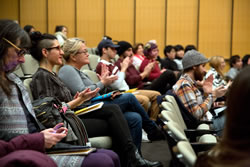
The development of this work has provided fertile opportunities for considering the contexts of presentation and the experience of the audience, and how these might constructively inform the compositional process. The resulting work is quite different from one that might have been developed for a traditional loudspeaker orchestra performance, and it is the scope of the project itself that afforded these opportunities for experimentation. We often become comfortable with our standard formats and we must be alert to the fact that these might be silently limiting the possibilities open to us. The theatre of performance with fixed media sound is one possible area for exploration in this field embracing the practices of contiguous art forms and bringing their understandings of audience experience into the development of new works.
The slow depletion of the magnetic tape provides an inevitability to the unfolding of the composition and the minimalism of the projector’s action provides a contained anchor against which the sonic materials can dance and swirl.
Projections is a work of sounds and light, of movements and gestures, of textures, of performance.
Closing Remarks

The divergent philosophies and practices which all feed into the rich world of audiovisual practice and performance are what make this area one of the most exciting and invigorating to explore. It is our hope that by opening up the processes of our practice and development within this project we might stimulate discussion and perhaps even provide a trigger for inspiration.
As technological limitations continue to recede and the workflows become more transparent, we are increasingly better positioned to embrace the expanded cinema dream of the intermedia æsthetic experience. Drawing inspiration from and collaborating with practitioners within parallel areas of practice allows us to engage with familiar problems in a new acoustic and light. Challenging us to question our fundamental definition of what audiovisual actually is and how we can bring art forms together to enhance the development of artistic practice in sound and light.
Bibliography
Adkins, Monty, Richard Scott and Pierre Alexandre Tremblay. “Post-Acousmatic Practice: Re-evaluating Schaeffer’s heritage.” Organised Sound 21/2 (August 2016) “Situating the Avant–Garde: Conformity and oppositional culture,” pp. 106–116.
Carvalho, Ana and Cornelia Lund (Eds.). The Audiovisual Breakthrough. Berlin: Fluctuating Images, 2015.
Cervantes, Miguel de. Don Quixote. Oxford: Oxford University Press, 1992.
Hill, Andrew. “Theatres of Sounds: The role of context in the presentation of electroacoustic music.” inSonic 2015. Proceedings of the Æsthetics of Spatial Audio in Sound, Music and Sound Art symposium (Karlsruhe, Germany: ZKM — Zentrum für Kunst und Medien, 26–28 November 2015).
_____. Projections (2017). [Score].
Lewis, Andrew P. “‘LEXICON’ — Behind the Curtain.” eContact! 15.4 — Videomusic: Overview of an Emerging Art Form / Vidéomusique : Aperçu d’une pratique artistique émergente (April 2014).
Mey, Adeena. “Expanded Cinema by Other Means.” In The Audiovisual Breakthrough. Edited by Ana Carvalho and Cornelia Lund. Berlin: Fluctuating Images, 2015, pp. 42–61.
R.E.M. “King of Birds.” Document. IRS Records, 1987.
Scott, Derek. “Postmodernism and Music.” In The Routledge Companion to Postmodernism. Edited by Stuart Sim. London: Routledge, 2001.
Tagg, Philip. “Music, Moving Image and the ‘Missing Majority’: How vernacular media competence can help music studies move into the digital era.” Proceedings of the 6th Music & The Moving Image conference (New York NY, USA: Steinhardt School, May 2011).
Youngblood, Gene. Expanded Cinema. Boston MA: E.P. Dutton, 1970.
Social top